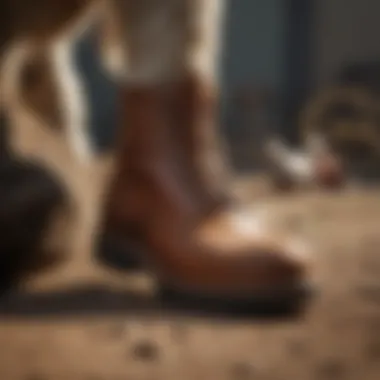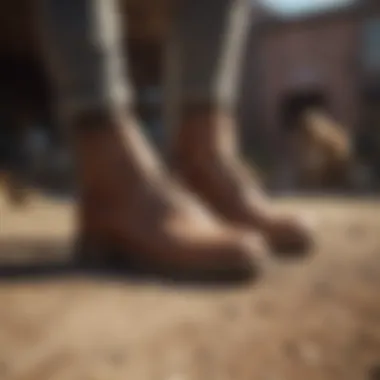Locating Your Nearest Goat Shoe Store


Intro
In the realm of agriculture, the significance of specialty footwear cannot be overstated. Specifically, goat shoe stores have emerged as essential suppliers for farmers and enthusiasts, catering to the unique needs of individuals engaged in this sector. These footwear options are designed to provide comfort, durability, and functionality. With various styles suited for different activities, locating the nearest goat shoe store becomes pivotal for those invested in agriculture and horticulture.
This article delves into how to effectively find these specialized stores while examining their broader impact on local economies and sustainable practices. By understanding the footwear available and considering the community benefits associated with local retailers, readers can enhance their agricultural practices.
Key Concepts and Terminology
Basic Definitions
To fully appreciate the importance of goat shoe stores, it is necessary to define some key terms:
- Goat Shoes: These are specialized footwear often designed for outdoor activities, offering appropriate traction and support.
- Horticulture: A branch of agriculture that deals with the art of garden cultivation and management, including the production of fruits, vegetables, and ornamental plants.
- Sustainability: The practice of conducting activities in a way that meets present needs without compromising the ability of future generations to meet theirs.
Historical Context
Historically, the use of specialized footwear in agriculture transcends mere utility. In many cultures, specific designs have evolved to address the various environmental challenges associated with farming, such as mud, rocky terrains, and varying weather conditions. As agriculture modernized, the demand for practical yet comfortable footwear led to the establishment of goat shoe stores, reflecting a growing understanding of the synergy between footwear and farming efficiency.
Recent Innovations and Trends
Technological Advancements
In recent years, the production of goat shoes has witnessed significant advancements. Innovative materials have improved durability while enhancing user comfort. Additionally, some brands have started to employ 3D printing technology in their manufacturing processes, allowing for customized shoe fits based on individual customer preferences. This tailored approach not only boosts performance but also reduces waste associated with conventional manufacturing.
Sustainable Practices
Sustainability has become an integral part of the agriculture narrative. Many goat shoe retailers are embracing eco-friendly practices by using recycled materials and promoting organic production methods. Supporting these businesses enhances the local community, fosters responsible consumption, and contributes to overall environmental well-being. The impact of such practices can extend beyond economics and into social realms, strengthening community ties and awareness of sustainable agriculture.
Practical Applications and Techniques
Step-by-step Guides
To locate the nearest goat shoe store effectively, follow these steps:
- Research Online: Use Google or a similar search engine to find local goat shoe retailers. Employ keywords like "goat shoes near me" or "agricultural footwear stores."
- Check Reviews: Once you find potential stores, read customer reviews to assess their reputation and quality of products.
- Visit Local Farmers' Markets: Often, local farmers will have recommendations for trusted suppliers, including goat shoe stores.
- Engage with Online Communities: Forums like Reddit can offer insights and firsthand experiences from fellow enthusiasts.
Case Studies
Looking at successful case studies provides further insight into the benefits of local goat shoe stores. For example, a goat shoe store in Oregon has not only boosted sales through specialized products but has also become a community hub. Hosting workshops on sustainable farming practices, this store exemplifies how local businesses can contribute positively to the agricultural landscape while promoting their products.
"Local stores play a monumental role in shaping sustainable agriculture. They serve as the nexus for community support and education." - Expert in Sustainable Practices
With this knowledge in hand, readers can make informed decisions, ensuring they choose the right footwear for their agricultural endeavors.
Understanding Goat Shoes
Goat shoes are not merely a foot covering; they represent a critical component in agriculture, particularly for those working with livestock. The correct footwear can greatly enhance comfort, efficiency, and safety while performing daily tasks within various agricultural settings. Goat shoes cater to specific environments and tasks, designed to meet the practical needs of farmers and outdoor workers alike.
Definition of Goat Shoes
Goat shoes are specialized footwear designed primarily for individuals who work with goats and other livestock. These shoes are typically constructed with durable materials that provide protection and comfort. Their design often includes features such as reinforced soles, slip-resistant traction, and weather-resistant fabrics. This footwear is essential in safeguarding the feet from various hazards found in farming environments, including sharp objects and uneven terrain.
Purpose of Goat Shoes
The purpose of goat shoes extends beyond simple foot protection. They serve multiple roles in enhancing the overall efficiency of farming operations. Comfortable footwear reduces fatigue during long working hours, enabling farmers to be more productive. Additionally, goat shoes offer specific functionalities such as:
- Traction: A good grip is vital for navigating slippery surfaces.
- Protection: Shields from potential injuries caused by equipment or terrain.
- Weather Resistance: Keeps feet dry and warm in different weather conditions.
- Support: Provides necessary arch and ankle support to prevent discomfort.


Types of Goat Shoes
There are several types of goat shoes available, tailored to distinct needs and environments. Understanding these types can help in selecting the appropriate pair. Common types include:
- Rubber Boots: Ideal for wet and muddy conditions; they are easy to clean and offer good protection against moisture.
- Field Shoes: Lightweight and designed for agility, these provide excellent traction on various terrains.
- Insulated Footwear: Used in colder climates, these shoes retain heat while keeping moisture out.
- Safety Boots: Equipped with features such as steel toes and slip-resistant soles, these provide extra protection in hazardous environments.
Every variety has its own set of advantages. Thus, farmers must consider their specific requirements when choosing the right goat shoes.
Importance of Local Goat Shoe Stores
Local goat shoe stores play a critical role in supporting both the agricultural community and the local economy. Understanding the importance of these stores goes beyond mere transactions; it encompasses community building, sustainable practices, and educational initiatives that enrich the farming lifestyle. These stores provide not only tools for farmers but also foster connections that are vital in today's agricultural landscape.
Community Support
Community support is a core pillar of local goat shoe stores. These businesses create a network among local farmers, offering a space where knowledge and experiences can be shared freely. By shopping at local stores, farmers contribute to the regional economy, helping to maintain jobs and support local artisans who create goat footwear.
Many stores also engage in community events, such as workshops and farmer markets, which allow for direct interaction between buyers and sellers. This strengthens local ties and encourages a sense of belonging. Supporting local stores is more than a transaction; it’s a commitment to the health and future of the community.
Sustainable Practices
Sustainability is another vital aspect of local goat shoe stores. Many of these retailers prioritize sourcing materials that are eco-friendly and promote ethical manufacturing practices. By choosing local stores, farmers can help to reduce their carbon footprint, as products are often sourced closer to home.
Additionally, goat shoe stores usually support local farms and materials, which further encourages sustainable agriculture. This not only helps in reducing waste and pollution but also enhances the resilience of local ecosystems. By being mindful of their purchasing decisions, customers can play an impactful role in preserving the environment.
Education and Awareness
Local goat shoe stores serve as hubs for education and awareness about agricultural practices, particularly concerning footwear. Many store owners are knowledgeable about the importance of proper goat shoe selection, highlighting factors such as comfort, durability, and appropriateness for specific farming tasks.
Workshops and informational sessions can be held to raise awareness of the advantages of using goat shoes specific to farming and animal care. This helps farmers make informed decisions and further fosters a culture of knowledge-sharing within the community. Education in such local settings empowers farmers, enhances their operations, and builds a more knowledgeable agricultural community overall.
"Investing in local goat shoe stores not only supports our own communities but also lays the foundation for sustainable agricultural practices that benefit us all."
How to Locate the Nearest Goat Shoe Store
Finding a goat shoe store is vital for those engaged in agricultural practices, particularly for goats and other livestock. These specialized stores offer a range of shoes designed to protect the animals' hooves and improve their overall well-being. In this section, the focus will be on the methods available for locating these stores effectively. Each method offers unique advantages, ensuring that farmers can find the right footwear for their goats quickly and without hassle.
Utilizing Online Resources
The internet has transformed how we access information. When searching for the nearest goat shoe store, online resources can provide immediate results. Websites such as Google Maps or specialized agricultural retail sites can reveal store locations based on your current position.
A few steps to maximize the benefits of online searches include:
- Entering specific queries like "goat shoe store near me" or "goat hoof care products."
- Checking customer ratings and reviews on platforms like Yelp to gauge store reliability.
- Joining online forums or communities, such as those on Reddit, that focus on farming equipment for additional recommendations.
Using these tools not only saves time but also provides insights into the products available at various locations.
Local Directories
Local directories still hold relevance in today's digital world. They serve as a curated source of information for businesses within a specific area. Farmers should consider using local business directories to find goat shoe stores nearby.
- Online directories, like Yellow Pages or local chamber of commerce listings, often categorize businesses by type.
- It is also beneficial to review a business' website or social media pages. These platforms typically provide details on product selection and store hours.
- In some areas, printed directories may be available at local community centers or libraries, covering agricultural services.
This approach allows individuals to discover stores that might be less visible online, enhancing the chances of finding unique or locally-made products.
Community Recommendations
Local communities often know the best sources for specialized products. Engaging with fellow farmers can surface invaluable recommendations. Hearing experiences from others can guide individuals to reliable goat shoe stores. Here are ways to gain insights from the community:
- Participating in local agricultural fairs or farmers' markets can present opportunities to connect with like-minded individuals and request recommendations.
- Engaging in social media groups focused on agriculture can yield suggestions from peers with similar interests.
- Informal conversations at regional meetups or events can provide an avenue for gathering information about reputable stores.


By leveraging community recommendations, you can often uncover stores that may offer superior products or customer service, which is fundamental for the health of your livestock.
Overall, combining various methods will significantly enhance your ability to locate the nearest goat shoe stores efficiently. Farmers can select ideal products, ensuring the care and safety of their goats.
Factors to Consider When Choosing Goat Shoes
Choosing goat shoes is a process that requires careful consideration. The right pair can affect comfort, performance, and safety while working on the farm. Selecting the appropriate footwear goes beyond simple aesthetics. It involves an understanding of various factors that can impact the work experience. Here, we will delve into three important aspects to keep in mind when selecting goat shoes: Material Options, Size and Fit, and Price Considerations.
Material Options
When it comes to materials, goat shoes come in several varieties. Each material offers its own benefits. The most common materials used in goat shoes include rubber, leather, and synthetic blends.
- Rubber is durable and provides excellent traction. It is ideal for wet environments, making it suitable for farms where mud is common.
- Leather is known for its comfort and longevity. It molds to the foot over time, offering a custom fit. However, it may not be as waterproof as rubber.
- Synthetic blends offer lightweight options and often come with moisture-wicking properties. This is beneficial for warmer climates where breathability is crucial.
Choosing the right material impacts the shoe's durability and comfort during extended use. This decision should be aligned with the specific farming conditions and individual preferences.
Size and Fit
Size and fit play a crucial role in the effectiveness of goat shoes. A proper fit ensures support and avoids discomfort or injury during daily tasks. Shoes that are too tight can cause blisters, while loose shoes can lead to slips or falls.
- It is advisable to measure your feet accurately and consult size charts from specific brands. Sizes may differ across various manufacturers.
- Consider the thickness of socks you will wear. If you use thicker socks, you may need a half size larger to accommodate them.
- Trying on shoes at the end of the day when your feet are most swollen can give a better idea of the fit you need.
Comfort is paramount. Shoes should have ample padding and support, especially in the arch area. This can reduce fatigue during prolonged wear, ultimately enhancing productivity.
Price Considerations
Pricing is an essential factor to consider when shopping for goat shoes. While it may be tempting to opt for the cheapest option, this can backfire in the long run. Durable shoes may come with a higher price tag, but they often save money over time through increased longevity.
- Budgeting for a quality pair should take priority. Balancing price and quality is essential to ensure long-lasting footwear that performs well.
- Look for sales or seasonal discounts from reputable stores. Sometimes, local stores may offer promotions on agricultural products.
- Consider the value of shoes based on features. Investing in safety and comfort can ultimately lead to fewer workplace injuries and increased efficiency.
"Quality footwear can prove to be an essential investment for farmers. It not only protects the feet but also aids in maintaining productivity."
By considering these factors—material options, size and fit, and price—better decisions can be made when selecting goat shoes. This ensures that the chosen footwear is suitable for the specific demands of farming, protecting both the feet and overall well-being.
Popular Goat Shoe Brands
The topic of popular goat shoe brands is essential for anyone looking to purchase the right pair for their needs. Given the specific requirements often found in the agricultural sector, the right footwear not only provides comfort but also ensures safety and efficiency in various tasks. Selecting a well-known brand can often correlate with quality assurance, innovation, and effective support. This guide will cover some of the leading brands in the goat shoe market, along with their key features and considerations for buyers.
Overview of Leading Brands
When looking at the leading brands, a few names consistently stand out in the goat shoe sector. These brands have established a reputation for producing high-quality footwear that meets the demands of farmers and enthusiasts alike. Some notable brands include:
- Sloggers: Known for their waterproof designs suitable for wet environments.
- Bogs: Offers insulated options, ideal for cold climates.
- Kamik: Provides durable construction with lightweight options for ease of movement.
These brands have invested heavily in research and development to create designs that not only protect the feet but also provide comfort during extended wear.
Comparative Analysis
A comparative analysis of these brands reveals distinct features that can help buyers make informed decisions. Different brands cater to various needs in terms of material, design, and pricing. Below are several factors to consider:
- Material Quality: Sloggers utilize rubber and PVC for weather resistance, while Bogs often feature neoprene for superior insulation.
- Design Style: Kamik emphasizes ergonomic design, providing enhanced comfort during long periods of wear.
- Pricing: Many consumers consider Bogs to be on the higher end of pricing, while Sloggers often come at a mid-range price point, making them accessible.
"Choosing the right goat shoe brand can significantly impact your experience in agricultural activities, so consider all factors and features before making a purchase."
In summary, understanding the popular goat shoe brands allows consumers to select footwear that best meets their operational needs while ensuring comfort and durability. Each brand carries unique offerings, and the decision should align with personal preferences, work requirements, and environmental conditions.
Maintenance of Goat Shoes
Proper maintenance of goat shoes is essential for ensuring their longevity and optimal performance. Goat shoes are designed to provide traction, comfort, and protection for the wearer. Without appropriate care, the functionality of these shoes can be compromised, affecting their usefulness on the farm or during other outdoor activities. Good maintenance practices can also enhance the overall aesthetic appeal of the footwear, thus improving the satisfaction of the owner.


Regular maintenance allows farmers and enthusiasts to maximize their investment in goat shoes. Clean and well-cared shoes contribute to better hygiene and can prevent problems such as infections or the buildup of dirt and debris that might jeopardize foot health. This section will cover important cleaning procedures and storage recommendations.
Cleaning Procedures
Cleaning goat shoes is a crucial part of maintenance. Different materials require distinct cleaning methods. Here are key steps:
- Remove Loose Debris: Before any washing, shake off dirt and debris. This can be done by gently knocking the shoes together.
- Use Appropriate Cleaners: For leather goat shoes, a mix of mild soap and water is advisable. For rubber or synthetic materials, a more vigorous solution may be used.
- Gentle Scrubbing: Utilize a soft brush or cloth to scrub away the tough spots. Pay attention to the crevices where mud and dirt accumulate.
- Rinse Thoroughly: It is vital to rinse the shoes well to ensure no soap residue remains. Using warm water can help remove stubborn grime.
- Drying: Air-dry the shoes at room temperature. Avoid using direct heat sources, as they can warp the material.
By adhering to these cleaning guidelines, the life expectancy of goat shoes can be significantly enhanced.
Storage Recommendations
Where and how goat shoes are stored can impact their condition. Here are some suggestions for effective storage:
- Dry Environment: Ensure that goat shoes are stored in a dry location. Moisture can lead to mold and mildew, which can damage the shoes.
- Temperature Control: Avoid extreme heat or cold; a stable temperature is ideal to prevent material from cracking or weakening.
- Use of Shoe Trees: Inserting shoe trees can help maintain the shape of the shoes during storage. This is particularly beneficial for leather shoes.
- Avoid Clutter: Store them in an organized manner where they won’t get squished or tangled with other items. Keeping them apart minimizes wear and tear.
Ultimately, these strategies play a significant role in the upkeep of goat shoes. By following these maintenance practices, farmers and shoe enthusiasts can enjoy the benefits of durable and effective footwear in their agricultural practices.
Integration of Goat Shoes in Farming Practices
The role of goat shoes in farming cannot be overlooked. These specialized shoes offer various benefits that directly affect farming efficiency and safety. As more farmers recognize the significance of proper footwear, their integration into everyday farming practices becomes increasingly essential. Goat shoes enhance productivity by providing necessary support and protection when working in diverse terrains.
Impact on Farm Efficiency
Efficiency on the farm can be significantly improved through the use of goat shoes. When farmers wear appropriate footwear, they can navigate rough and uneven terrains without fear of injuries. This aspect is crucial, especially during tasks that require long hours of standing or walking. Proper cushioning in goat shoes reduces fatigue, allowing workers to maintain higher productivity levels throughout their shifts.
Moreover, goat shoes are designed for durability. They resist wear and tear much better than regular shoes. This feature saves farmers money in the long run, as they do not need to replace their footwear frequently. A sturdy, reliable pair of goat shoes provides grip on slippery surfaces, helping to prevent accidents. Overall, using goat shoes minimizes downtime due to injuries or equipment failure, thereby optimizing farm operations.
Safety Considerations
Safety is a primary concern for farmers. Wearing goat shoes can significantly reduce the risk of slips, trips, and falls—common hazards on any farm. These shoes often incorporate safety features such as slip-resistant soles and reinforced toe caps, protecting farmers from potential injuries caused by heavy objects or adverse conditions.
Additionally, many goat shoes are made with waterproof materials. This quality keeps feet dry and warm, especially when working in wet fields, reducing the risk of hypothermia. Awareness of the conditions one works in is important; goat shoes provide that necessary safeguard against harmful elements.
Investing in proper goat shoes not only protects the farmer but also ensures that the work continues smoothly, minimizing accidents and enhancing overall farm vitality.
Trends in Goat Footwear Market
Understanding trends in the goat footwear market helps consumers and farmers make informed decisions. This section explores how evolving preferences and new technologies are shaping this niche sector. These trends influence not only the designs and functionalities of goat shoes but also the sustainability practices within the industry.
Evolving Consumer Preferences
The modern consumer increasingly prioritizes comfort, durability, and environmental impact when choosing goat shoes. This shift is partly due to the growing awareness of sustainable practices.
- Comfort and Fit: The fit of goat shoes has become paramount. Many buyers now expect adjustable features and breathable materials. This ensures the shoes can accommodate various conditions during farming work. People want footwear that supports them through long hours.
- Sustainability: Many customers care about where their products come from. Consumers are now looking for shoes made from ethically sourced materials. Brands that embrace sustainable manufacturing processes gain favor among this conscientious market segment.
- Style: While functionality is important, aesthetics also play a role. Buyers want shoes that look good and fit into their lifestyle. This has led to an increase in color choices and designs not traditionally associated with goat shoes.
Evolving preferences indicate a shift towards footwear that meets both practical needs and ethical standards.
Technological Innovations
Technology plays a significant role in enhancing goat footwear. Innovations focus on improving the design and functionality of shoes to better serve farmers and enthusiasts.
- Material Innovation: There is a trend toward using advanced materials that are resistant to wear and environmental factors. For instance, waterproof options allow for use in all weather conditions without sacrificing comfort.
- Smart Technologies: Some brands are integrating smart technology into their products. Features may include moisture-wicking capabilities or temperature regulation. Such innovations keep feet comfortable during long working hours.
- Eco-Friendly Production: Many manufacturers are incorporating technology that minimizes waste. Advanced manufacturing processes, such as 3D printing, reduce material waste significantly.
Overall, technological advancements not only enhance footwear quality but also address environmental concerns.
"The goat footwear market is evolving. Consumers want shoes that fit their changing needs and values."
Staying aware of these trends is essential for anyone involved with goat shoes. By understanding these shifts, consumers can choose products aligned with their values and needs.
End
Summary of Key Points
Locating a goat shoe store involves several strategies. Using online resources and local directories can streamline the search process. Community recommendations also play a crucial role. Moreover, factors such as material options, size, fit, and pricing should be carefully weighed before making a purchase. Awareness of popular brands can inform better choices and enhance satisfaction with the product.















